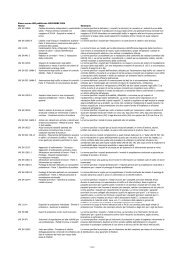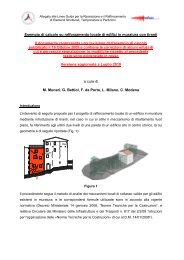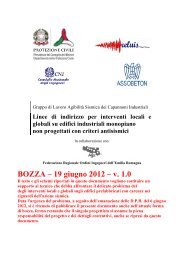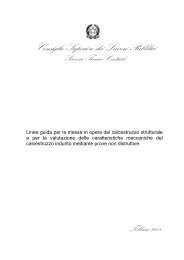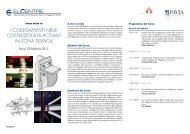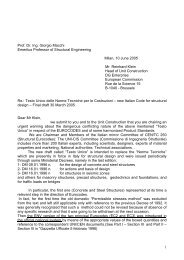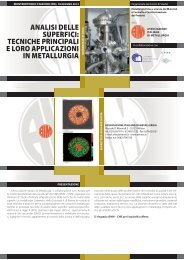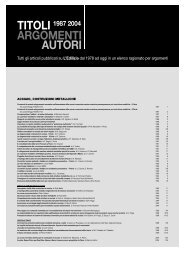Combinazioni di Verifica agli stati Limite: il non ... - Steelchecks.com
Combinazioni di Verifica agli stati Limite: il non ... - Steelchecks.com
Combinazioni di Verifica agli stati Limite: il non ... - Steelchecks.com
Create successful ePaper yourself
Turn your PDF publications into a flip-book with our unique Google optimized e-Paper software.
19<br />
3.3 Effetto inf-sup<br />
Le norme si premurano <strong>di</strong> spiegare che nel caso in cui un carico permanente produca un<br />
effetto favorevole, <strong>il</strong> suo coefficiente γ deve valere 1 e <strong>non</strong> 1.4. Questo vuol <strong>di</strong>re che ciascun carico<br />
permanente in<strong>di</strong>pendente deve assumere <strong>il</strong> suo valore superiore (γ g =1,4) o <strong>il</strong> suo valore inferiore<br />
(γ g =1). Di questo <strong>non</strong> abbiamo tenuto conto nel nostro esempio, sino ad ora.<br />
Si noti che in una struttura reale <strong>non</strong> è affatto possib<strong>il</strong>e <strong>di</strong>re a priori che per tutti gli elementi<br />
strutturali un carico permanente al valore superiore rappresenti <strong>il</strong> massimo cimento: al contrario si<br />
deve sostenere che in ogni struttura reale esistono uno o più <strong>com</strong>ponenti che devono essere<br />
verificati anche per <strong>com</strong>binazioni che <strong>com</strong>portino i valori inferiori dei carichi permanenti. Si pensi<br />
ad esempio alla possib<strong>il</strong>ità <strong>di</strong> trazione nelle colonne o alla verifica delle fondazioni sotto effetti<br />
ribaltanti quali normalmente producono vento o sisma.<br />
Ricor<strong>di</strong>amo che <strong>non</strong> è affatto corretto assumere che <strong>il</strong> valore superiore o inferiore dei carichi<br />
permanenti debba presentarsi in contemporanea tra essi: ogni con<strong>di</strong>zione <strong>di</strong> carico permanente è<br />
in<strong>di</strong>pendente dalle altre ed ha una <strong>di</strong>stribuzione spaziale <strong>di</strong>versa, e quin<strong>di</strong> si possono dare casi in cui<br />
<strong>il</strong> peggio avviene per particolari sequenze <strong>di</strong> sup/inf nei vari casi <strong>di</strong> carico <strong>di</strong> tipo permanente.<br />
Se si tiene conto della variab<strong>il</strong>ità inf/sup <strong>di</strong> ciascuno dei due carichi permanenti che sono<br />
<strong>stati</strong> ipotizzati per la nostra struttura, si ottiene che <strong>il</strong> numero <strong>di</strong> <strong>com</strong>binazioni passa a 291. Il<br />
numero è sostanzialmente ottenib<strong>il</strong>e moltiplicando per 4 <strong>il</strong> numero <strong>di</strong> precedenti <strong>com</strong>binazioni (73),<br />
e togliendo 1 (quella coi carichi permanenti da soli già esistente). Il numero 4 deriva dal fatto che si<br />
possono dare le seguenti possib<strong>il</strong>ità per i casi 1 e 2:<br />
• sup/sup<br />
• sup/inf<br />
• inf/sup<br />
• inf/inf<br />
mentre in precedenza avevamo considerato <strong>il</strong> solo caso sup/sup. Si riba<strong>di</strong>sce che i carichi<br />
permanenti possono in generale essere applicati a zone <strong>di</strong>fferenti della struttura: per esempio <strong>il</strong> peso<br />
proprio strutturale può essere equi<strong>di</strong>stribuito sulla struttura, mentre i carichi permanenti portati<br />
possono riguardare una parte specifica della struttura (ve<strong>di</strong> fig. 1).<br />
A questo punto dobbiamo constatare che analogo ragionamento sui valori superiore ed<br />
inferiore deve essere fatto per ciascun carico variab<strong>il</strong>e, nessuno escluso (ed è questo <strong>il</strong> motivo per<br />
cui <strong>il</strong> γ q a fattor <strong>com</strong>une della (1) è errato). Infatti data la arbitraria <strong>di</strong>sposizione dei carichi nello<br />
Paolo Rugarli – <strong>Combinazioni</strong> <strong>di</strong> <strong>Verifica</strong> <strong>agli</strong> <strong>stati</strong> <strong>Limite</strong>: <strong>il</strong> <strong>non</strong> detto delle Normative



